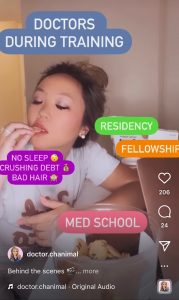By Tiffany Chan, MD
Let’s face it. No one knows what we do.

Aspiring medical students don’t know how to become diagnostic radiologists. Other physicians think we’re a bunch of introverts in dark rooms. The public thinks their OB-GYN reads their mammograms, because they’re the ones who say, “Your mammogram looks good!”
So how can we educate the public, aspiring medical professionals, and our clinician colleagues about our field? When done effectively, social media can be the answer. It can inspire future generations to consider radiology as a career, put a face to the radiologist behind clinical care, and alleviate common patient concerns. And the beauty of social media is that it reaches a substantial audience that our best papers and most acclaimed conferences cannot. Do your neighbors read Pubmed? No. But they probably have an account on Facebook or Instagram.
On social media, you catch someone’s attention by using visually interesting content that is easy to understand. If you post enough of these images, you’ll gain followers and more people will see your posts. But this is hard for radiologists, because the interpretation of medical imaging is too difficult for most people to understand. Why do you think dermatologists and plastic surgeons are so popular on social media? They can show pictures of bad skin or a before/after rhinoplasty and we all understand what’s happening!
There are many popular radiology pages that are dedicated to showing de-identified medical images. If you’re hoping to gain a more general audience, though, you can’t just show a CT and expect anyone to know what you’re talking about. Ultrasound? Forget it – even with annotations, it looks like a blurry snowstorm. I’ve tried and was met with crickets. But I have come up with some ideas for creating engaging radiology content on social media (in particular, Instagram) intended for the non-radiologist audience.
Use your different identities

Make radiology relatable
This takes creativity. I’ve learned that radiology content is more likely to garner interest if you can connect imaging to the patient experience. For instance, people care more about how a breast lump might be a cyst than about how a cyst appears on ultrasound. You can use this as a jumping-off point to explain why we use ultrasound in our workup.
Another method is to channel your inner non-radiologist. If you were a patient or clinician, what concerns would you have? I would have many questions about radiation, why there are so many different types of imaging, and why outside imaging is so important. (If I were a patient, I’d probably then read my radiology report and get stressed out by all the weird words). These are all topics I have posted about because they are common questions and concerns.
Lastly, don’t forget that, even as specialists, we went to medical school and completed an intern year. We spent a large part of our training with clinician colleagues and therefore can post about medical training – for example, the importance of medical school friendships or how difficult but worthwhile residency is. Your post will resonate with other attendings, give hope to current trainees, and emphasize to your nonmedical audience what their doctors go through to gain the skills required to take care of them.
More images, fewer words

Speaking of captions
Keep them short! People don’t scroll on social media to read lengthy paragraphs. If your message is on the longer side, be sure to use captivating words in the first line of the caption since those are the only words initially displayed on a feed. Another trick is to use interesting fonts (which you can easily do using online font generators).
Make it interactive!
Occasionally, I create interactive stories (temporary posts that disappear after 24 hours) using de-identified images and colorful, fun annotations. For example, I did a series on the importance of breast tissue density by showing mammograms of various densities. To demonstrate how density can hide cancers, I added a white cartoon bunny on two mammograms – one of a fatty breast and one of a dense breast. I then asked my audience (via quizzes and polls) which mammogram showed the bunny more easily. In this way, I was able to explain what breast density is while also showing how it affects our ability to detect cancers. I have had many positive responses to these types of stories from students and non-radiology physicians, and I think it’s because they demonstrate the thought process behind medical imaging interpretation.
Use fun audio in your videos
If you’re creating a video, the trend is to incorporate audio with lyrics or sound effects that are directly related to your content. For instance, I created a video on how to become a radiologist accompanied by “This is How We Do it” by Montell Jordan. Another option is to choose audio from popular songs. A lot of the audio that accompanies current trends or video challenges comes from Tik Tok videos. For example, the Magic Bomb song where people clap along with the beat and dispel myths about their career. It’s perfect for those of us who can’t dance!
Most important…
Remember to have fun with it! We need more people to share how awesome radiology is with the world. We may sometimes work in the shadows, but we certainly don’t have to live there!
Tiffany L. Chan, MD is a board-certified radiologist and serves as an assistant clinical professor in breast imaging at UCLA. Dr. Chan completed her diagnostic radiology residency at Penn State and breast imaging fellowship at UCLA. She is passionate about resident and medical student education as well as patient empowerment. She is the senior breast imaging representative of the Los Angeles Radiological Society and a member of the Society of Breast Imaging Social Media Committee. Dr. Chan is always looking for new, fun ways to share how awesome radiology is with the world and can be followed on Instagram and Twitter.


